How to Use Webinars to Boost SALs and SQLs

This post is the latest in our series on B2B marketing optimization and how to take your marketing efforts to the next level.
In our last post, we looked at how to optimize webinars to increase engagement and drive conversion. However, from examining your performance across the customer journey, you may find a bottleneck at the point where marketing hands its MQLs over to sales — even if your sessions have engaged brilliantly.
Where this problem might identify itself is in the proportion of MQLs that become sales-accepted leads (SALs) and sales-qualified leads (SQLs).
Because this has an impact on marketing’s contribution to the pipeline, it’s something marketers need to monitor and find ways to keep the process moving forward smoothly. In this post, we are going to see how you can use webinars to improve this metric.
Find out from sales what’s behind SALs and SQLs
Because a marketer’s job does not stop at the handover of an MQL to sales, you need to monitor your CRM for what happens to those MQLs. Do they become SALs or an SQL or do they get disqualified somewhere along the way? And, if they were disqualified along the way, why?
The best way to find out is to go directly to the source. Speak to sales directly and identify what stops leads from being accepted. Are leads going cold because they aren’t being picked up as quickly as they should be? Is there information about the leads that marketing isn’t including in their lead scoring process that is causing leads to be rejected when they get to sales? What questions and approaches do sales use to qualify a lead?
Use these elements to optimize your webinars
In B2B sales, getting to conversion means you need to start a conversation. So, you can use your webinars to ask the questions sales reps typically pose and begin the conversation during your session. As an example, if sales wants to know about potential budgets, you can then build a question about budgets into a poll and then pass those results over to sales.
While it’s always possible for marketing to start conversations within a webinar and then manually hand prospects over to sales to continue and expand those conversations, it is also helpful to have someone from sales on the webinar. They can either be out in front presenting or in the background doing Q&A.
However, keep in mind it’s not all about metrics. You want to enable your sales to develop one-on-one connections and webinars can help with that.
Bring webinar data into the workflow of your sales team
Another way you can help marketing leads to become sales-accepted leads is to bring the insights gained through your webinars into the tools they use — namely, the customer relationship management platform.
And that’s where ON24’s Prospect Engagement Profile can help. As sales team members can see the actions and engagement points an individual takes during a webinar. This can help improve conversations by providing talking points based on what they have read or consumed.

Encourage webinars as an always-on sales enablement tactic
All marketers want sales to have the tools they need so that they can do their jobs effectively. Webinars can act as a great sales enablement tool — both as a live session and one that is always on, ready for viewing.
For example, if members of the sales team are struggling with qualifying a lead because it has either gone cold or they are not getting a response, sales can invite them to attend a live webinar to ask questions, or refer them to a past webinar that they can watch in their own time. This can help to reignite engagement and conversation which can move the lead closer towards being sales-qualified.
Align promotion of webinars specifically for the sales stage
Consider creating webinars that are specifically for leads that have been marketing qualified but have not progressed into opportunities. Typically these will be aligned further towards the end of the buyer journey, containing information to help them become engaged and interested in speaking to sales.
This could include conducting customer webinars, where you invite your brand advocates to come on and talk about how successful they have been using your product or service or go over case studies. Also, consider creating an on-demand demo webinar — Sage Intacct, for example, manages to drive 50% of their webinar pipeline purely from a daily demo webinar.
Use your marketing automation system to identify and target just those leads which have reached MQL status, but are yet to become SQLs.
Monitor, test, improve
No matter what you are doing, be it amending your webinars to fill in the gaps for SALs and SQLs, creating webinars as a sales enablement tactic or creating webinars specifically for that stage of the buyer’s journey, you need to always be monitoring, testing and optimizing your strategy over time. And don’t forget to make sure marketing gets credit for opportunities in your CRM.
Webinars also make great tools for sales enablement training. To find out more, read about how ON24 can help with your sales enablement training.